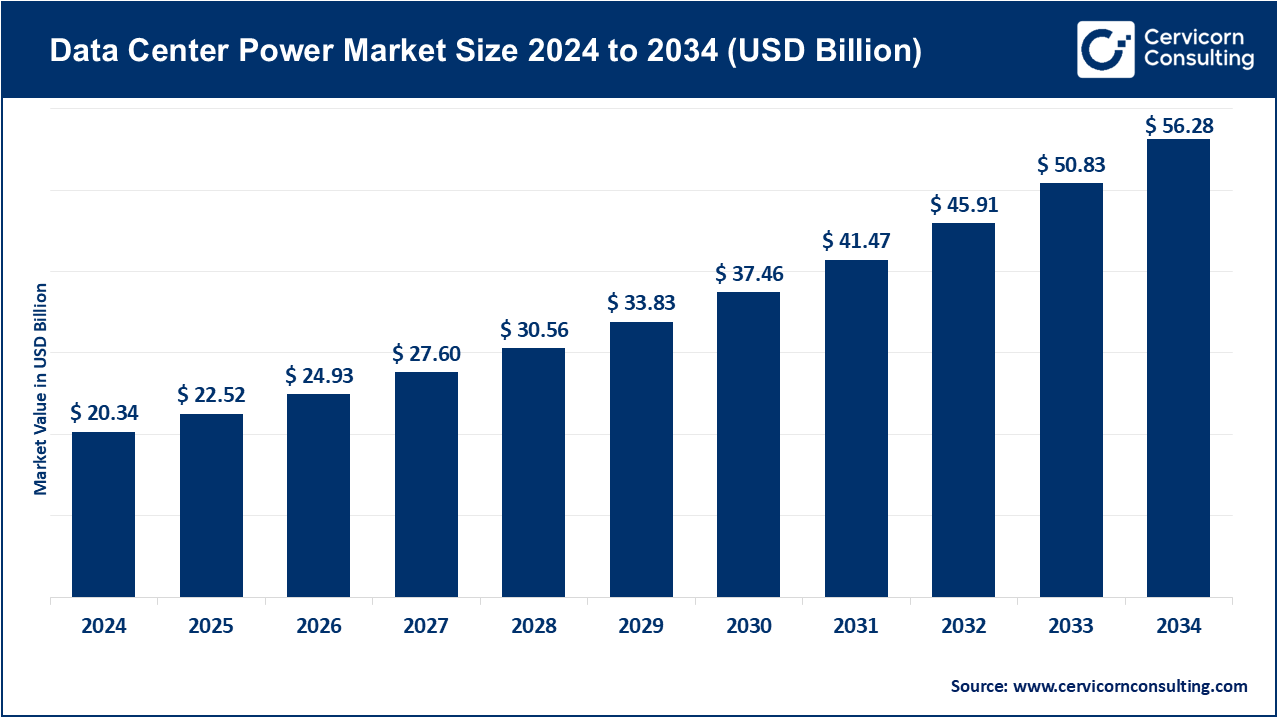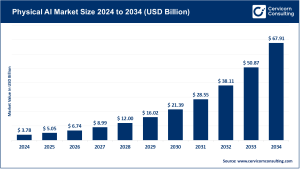Data Center Power Market Overview
The global data center power market reached a valuation of about USD 20.34 billion in 2024 and is projected to climb to USD 56.28 billion by 2034, growing at a CAGR of 10.71% from 2025 to 2034. This strong expansion underlines the rising demand for energy-efficient, scalable, and resilient power infrastructure to support hyperscale expansions, AI-intensive workloads, and the rapid rollout of cloud and edge computing networks. Factors such as higher rack power densities, greater integration of renewable sources, and increasing sustainability mandates are reshaping how data centers generate, distribute, and optimize their energy consumption worldwide.
Get a Free Sample: https://www.cervicornconsulting.com/sample/2734
Key Market Trends
1. Integration of Renewable Energy and Hybrid Systems
The market is witnessing accelerated adoption of renewable energy sources including solar, wind, and hydro, paired with battery energy storage systems (BESS). Leading operators are increasingly entering into power purchase agreements (PPAs) and investing in microgrids to ensure resilience while aligning with sustainability goals. For example, hyperscale firms like Microsoft and Google are operating on campuses powered entirely by renewable energy to achieve net-zero carbon targets.
2. AI-Powered Power Monitoring and Management
Artificial intelligence and machine learning are being deployed in areas like predictive maintenance, load optimization, and digital twin simulations. These tools enhance operational efficiency and reduce downtime. With AI workloads requiring extremely high power levels, real-time monitoring of power usage effectiveness (PUE) has become mission-critical.
3. Modular and Prefabricated Power Solutions
The adoption of prefabricated electrical rooms, containerized UPS units, and modular switchgear is reducing deployment times and costs. These solutions are particularly attractive for edge data centers and fast-growing hyperscale projects, especially across Asia-Pacific, where demand is expanding at a rapid pace.
4. High-Density Power Architectures
As the use of GPUs and AI accelerators increases, rack power densities have surged from 5–10 kW to 30–60 kW, with hyperscale operators planning some racks at 100 kW. This evolution is driving the development of advanced PDUs, busways, and liquid-cooling-ready power systems to maintain both uptime and energy efficiency.
5. Regulatory and Policy-Driven Efficiency Measures
Governments—particularly in the European Union—are imposing requirements for energy-efficiency reporting, renewable integration, and waste-heat reuse. Policies such as the EU Code of Conduct for Data Centre Energy Efficiency are pushing operators to adopt greener infrastructure and reporting practices.
Market Drivers
Explosive Growth in Cloud and AI Workloads
The massive adoption of cloud platforms and AI/ML workloads is driving demand for high-performance power systems. By 2030, AI workloads alone are expected to consume 10–15% of global data center power, up from under 2% in 2020.
Government Incentives and Sustainability Mandates
Countries across the globe are introducing incentives to encourage energy-efficient retrofits and renewable integration. For example, India offers fiscal incentives and electricity duty waivers for green data centers, while in the United States, tax credits are supporting investments in renewable PPAs and energy storage.
Rising Compute Density and Edge Deployments
The rise of edge computing is fueling the establishment of thousands of micro data centers located closer to users. These facilities require compact, highly reliable, and remotely managed power solutions, making modular UPS and hybrid systems essential growth areas.
Technological Advancements in Power Electronics
Innovations like lithium-ion UPS, solid-state transformers, and advanced power management software are reducing operating costs and increasing efficiency. These technologies are helping both enterprises and colocation providers achieve better uptime with lower TCO.
Impact of Trends and Drivers
-
Hyperscale Operators are leading renewable energy integration and AI-driven monitoring, particularly influencing North America and Europe.
-
Colocation Providers are embracing prefabricated solutions to provide faster deployment for enterprise and cloud clients.
-
Emerging Markets across Asia-Pacific, the Middle East, and Latin America are experiencing accelerated edge deployments, fueled by internet penetration, supportive policies, and localized cloud demand.
-
Regulatory Environments in Europe are pushing waste-heat reuse and stricter PUE optimization, while North America emphasizes resilience and hybrid solutions.
Challenges and Opportunities
Challenges
-
Rising energy consumption may strain regional power grids.
-
High costs of renewable integration and large-scale battery storage.
-
Regulatory variations across regions complicate global expansion strategies.
Opportunities
-
AI-based power management is creating new service opportunities.
-
Growth of edge data centers is driving demand for modular and prefabricated power systems.
-
The expansion of green financing and sustainability-linked investments supports renewable-driven infrastructure upgrades.
Future Outlook
The future will revolve around renewable-ready infrastructure, hybrid energy systems, AI-powered monitoring, and modular deployments. Companies prioritizing sustainability, scalability, and resilience will be best placed to capitalize on this rapidly evolving market.
Contact Us for a Detailed Overview: https://www.cervicornconsulting.com/data-center-power-market

